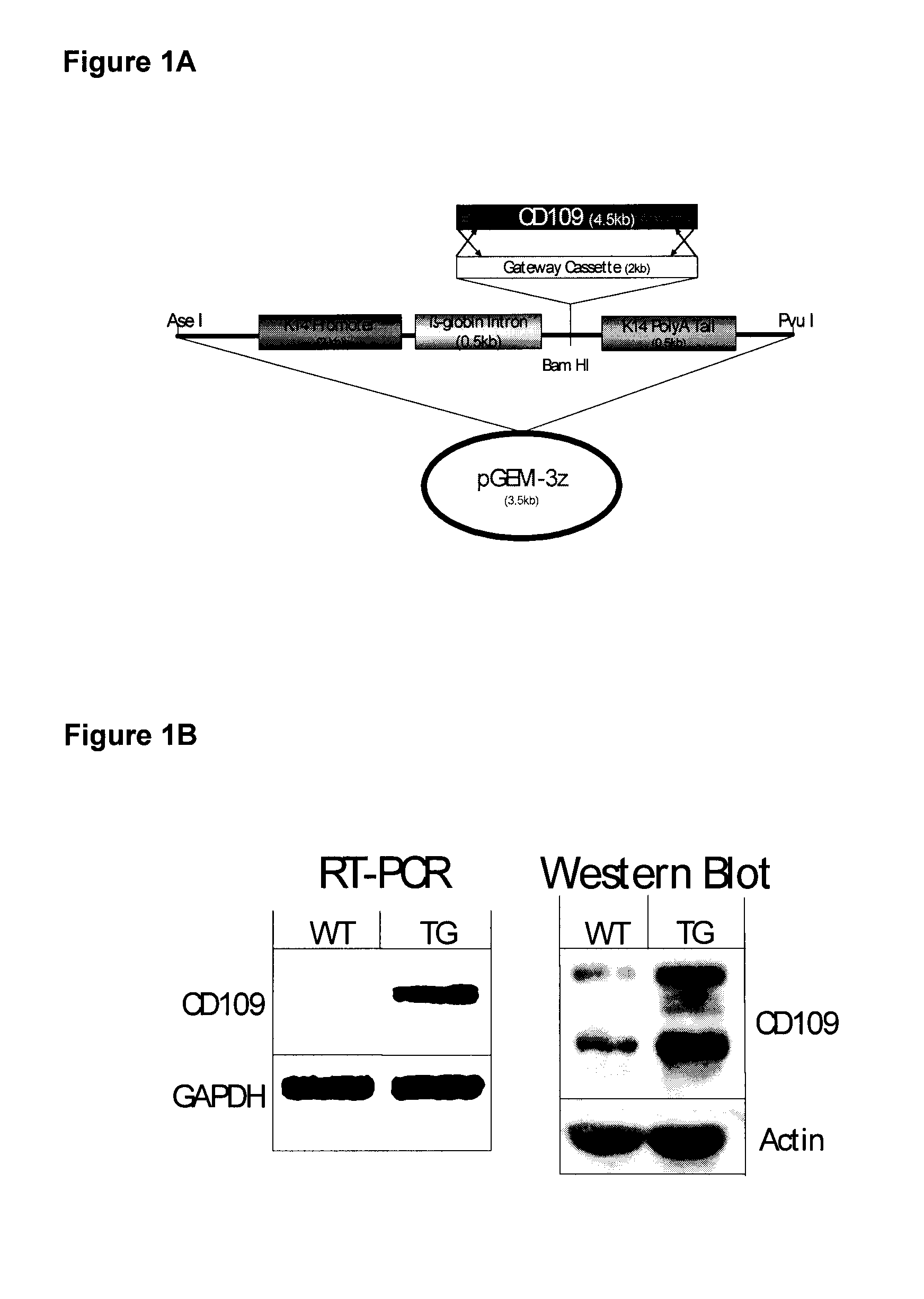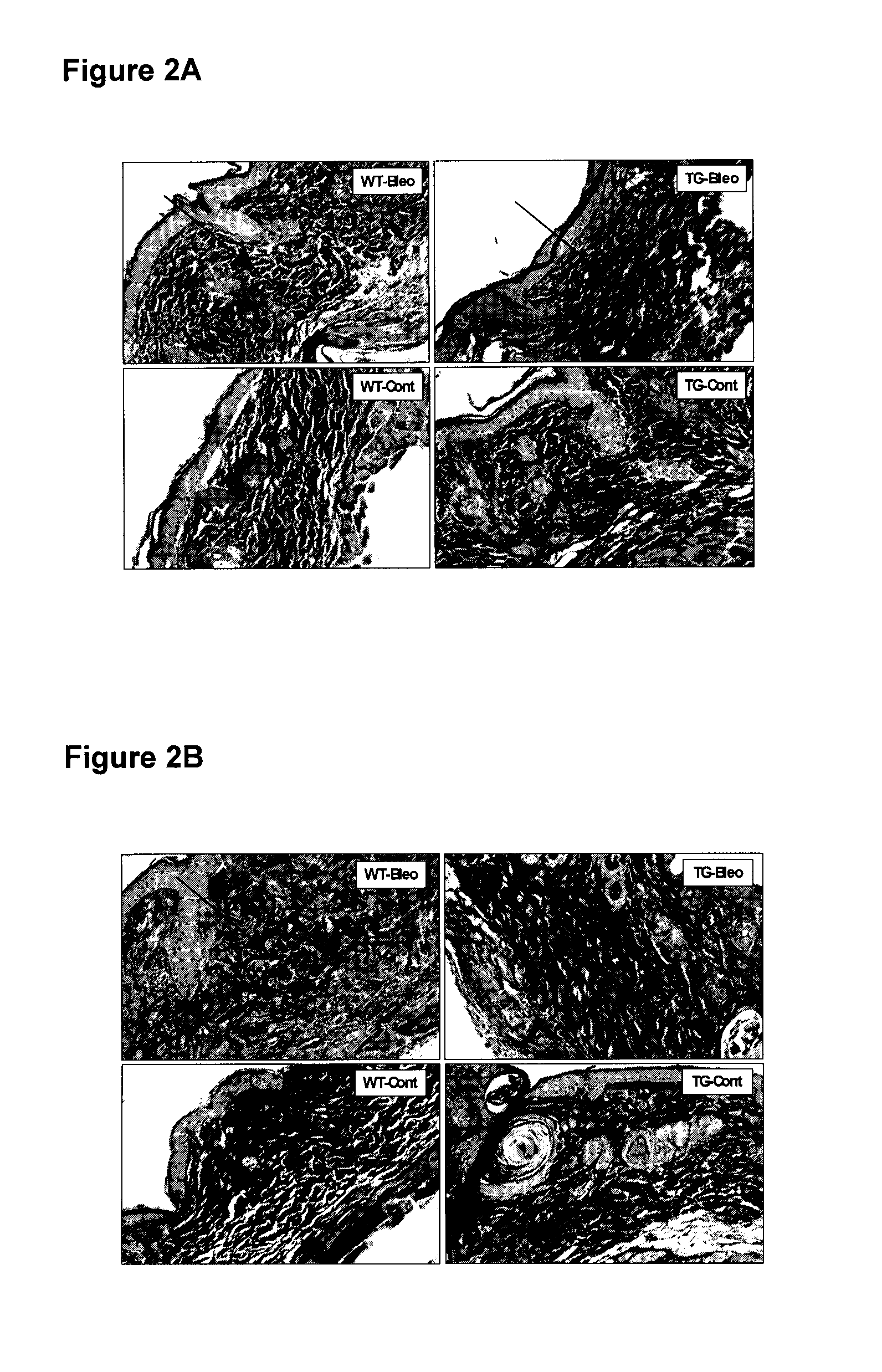Cd109 polypeptides and uses thereof for the treatment of skin cells
a technology of cd109 and polypeptides, applied in the field of dermatology, can solve the problems of scarring excessive/abnormal, patients with scars may experience a disruption of daily activities, anxiety and depression, and social acceptance difficulties,
- Summary
- Abstract
- Description
- Claims
- Application Information
AI Technical Summary
Benefits of technology
Problems solved by technology
Method used
Image
Examples
example 1
Transgenic Mice Overexpressing CD109 in the Epidermis: Bleomycin-Induced Skin Fibrosis Mouse Model
[0117]Bleomycin-induced fibrotic mouse model has become a well recognized in vivo model for scleroderma and other fibrotic disorders (Yamamoto and Nishioka, Arch Dermatol Res, 2004. 295(10): p. 453-6). It has been well documented that TGF-β signaling has a strong impact on the onset of the fibrosis in this model (Lakos Am J Pathol, 2004. 165(1): p. 203-17). In the current study, transgenic mice overexpressing CD109 in the epidermis were generated and these mice and their control littermates were injected intradermally with bleomycin or vehicle control (PBS) to determine if CD109 affects fibrosis. By analyzing collagen organization, extracellular matrix deposition (ECM) and dermal thickness of both the wild-type and transgenic mice, we were able to show that CD109 significantly ameliorates the bleomycin-induced fibrotic response in vivo.
Materials & Methods
[0118]Generation of Transgenic M...
example 2
Transgenic Mice Overexpressing CD109 in the Epidermis: Wound Healing Studies
[0128]Using established wound models, the current experiments were carried out to determine the effect of CD109 on various wound healing parameters and its abilities to reduce scarring. Theses results demonstrate that CD109 transgenic mice display more organized collagen and ECM deposition, reduced granulation tissue formation and decreased numbers of immune cells (macrophages and neutrophils) as compared to wild-type littermates suggesting that CD109 reduces inflammation, promotes granulation tissue resolution and improves scarring. Furthermore, CD109 did not affect the wound closure macroscopically, at the histological level, suggesting that it improves scarring without altering the normal wound healing response. Taken together, these results support CD109 therapeutic value in the treatment of pathological scarring such as keloid formation and hypertrophic scarring and in improving surgical scars.
Materials...
example 3
Efficacy of Recombinant CD109 Protein and a CD109-Based Peptide as Anti-Scarring Agents
[0151]To explore the potential of CD109 as a TGF-β1 antagonist, the efficacy of recombinant CD109 protein and a CD109 peptide based on the putative TGF-β binding region was examined for their ability to bind TGF-β1 and inhibit TGF-β1 signaling in vitro. The results demonstrate that it may be possible to specifically manipulate the action of TGF-β1 and the TGF-β1 / β3 isoform ratios, using the full length protein and the CD109 peptide based on the putative TGF-β binding region. This suggests these proteins may be of use as therapeutic anti-scarring agents.
Experimental
[0152]Affinity labeling assay: CD109 protein and peptides were tested for their ability to compete with I125TGF-β1 for the TGF-β signaling receptors in an affinity labeling assay. HaCaT cells were incubated with I125TGF-β1 in the presence or absence of soluble CD109 protein and CD109 peptides. Proteins from the cell membrane extracts wer...
PUM
| Property | Measurement | Unit |
|---|---|---|
| time | aaaaa | aaaaa |
| time | aaaaa | aaaaa |
| temperature | aaaaa | aaaaa |
Abstract
Description
Claims
Application Information
 Login to View More
Login to View More - R&D
- Intellectual Property
- Life Sciences
- Materials
- Tech Scout
- Unparalleled Data Quality
- Higher Quality Content
- 60% Fewer Hallucinations
Browse by: Latest US Patents, China's latest patents, Technical Efficacy Thesaurus, Application Domain, Technology Topic, Popular Technical Reports.
© 2025 PatSnap. All rights reserved.Legal|Privacy policy|Modern Slavery Act Transparency Statement|Sitemap|About US| Contact US: help@patsnap.com



